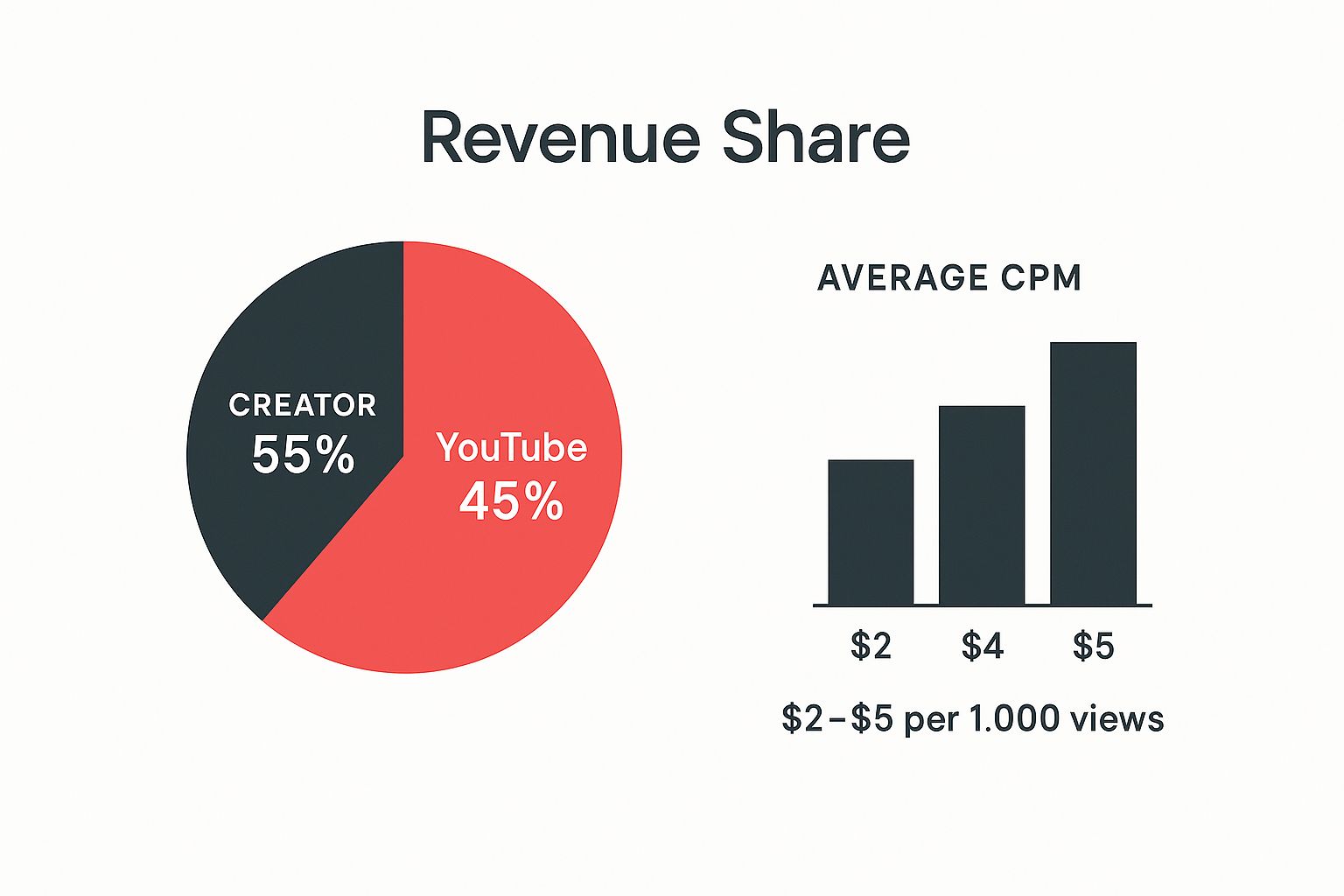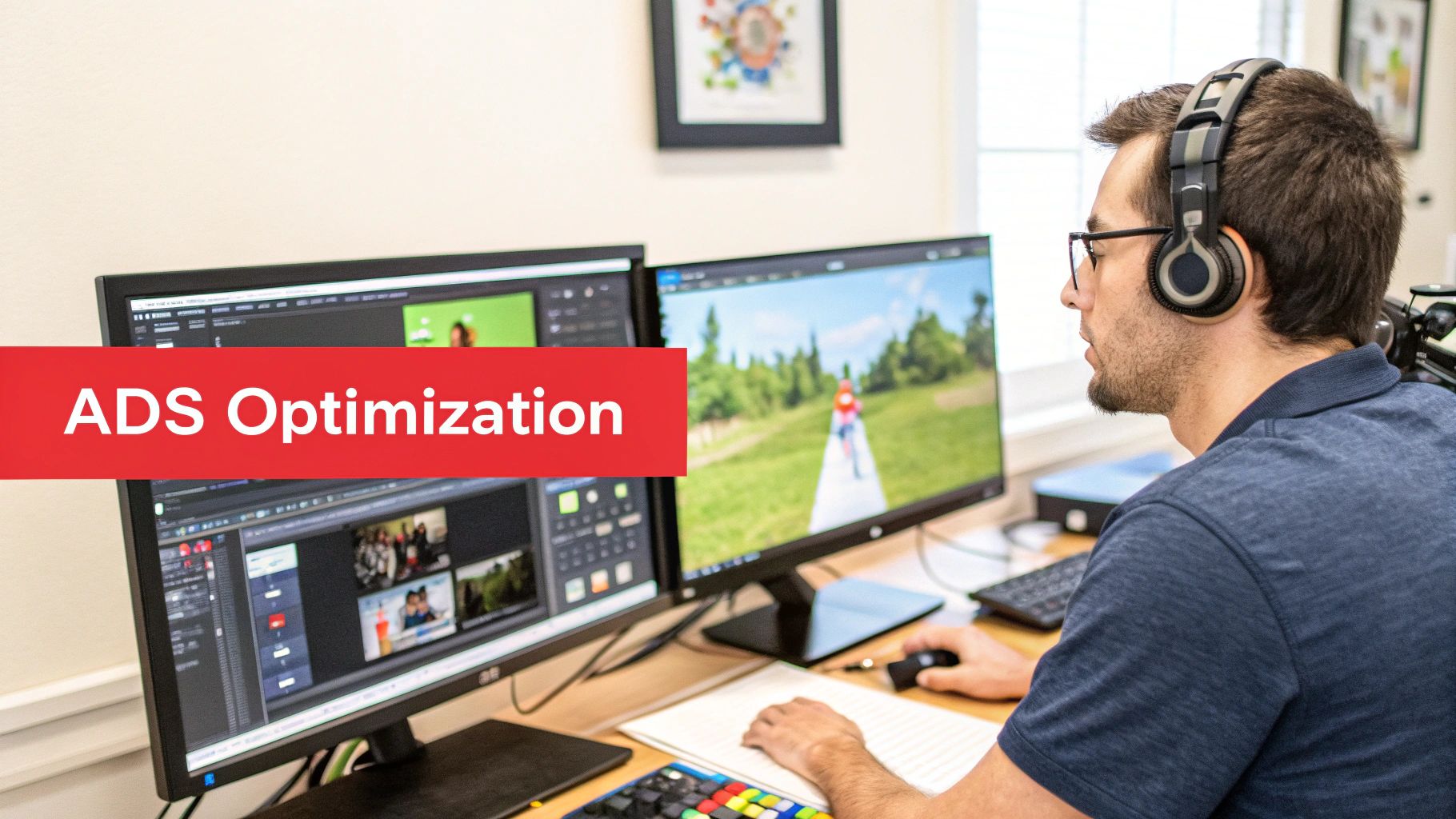The Real Potential of YouTube Ad Revenue Today

Earning money through ads on YouTube is a dream for many. But it’s important to understand how it all works. Let’s dive into the reality of YouTube ad revenue.
Understanding the YouTube Advertising Ecosystem
The YouTube advertising world is a bit complex. Cost Per Mille (CPM) is a key term. It's what advertisers pay for one thousand views. CPMs change depending on who your audience is, what your videos are about, and even the time of year. For example, tech videos aimed at people in the U.S. might have a higher CPM than videos about a niche hobby with a smaller audience. This CPM difference means different earning potential.
Your Revenue Per Mille (RPM) shows what you actually earn. It factors in YouTube's cut and that not every view earns you money. Knowing both CPM and RPM helps you make smart choices. Want to learn more about making money from videos? Check out this article: 7 Proven Ways How To Monetize Videos In 2025.
Factoring in Current Trends and Statistics
Understanding potential revenue streams is essential. In 2024, YouTube made $36.1 billion from ads. That's a big jump from past years, with a 14.6% increase in 2024 alone. Big channels like Mr. Beast earned a lot, reportedly $85 million in 2024.
Successful YouTubers know it’s important to make content that people in big markets like India, the U.S., and Brazil want to watch. These are some of the top countries for YouTube users. Getting lots of views and engagement is key to earning more ad revenue. For a deeper dive into YouTube statistics, visit: https://www.businessofapps.com/data/youtube-statistics/
YouTube’s growth shows the platform's potential. But remember, individual earnings can be very different.
Visualizing Earning Potential: A Data Chart Breakdown
The data chart below shows estimated yearly ad revenue for different YouTubers. It compares creators with different subscriber counts and average views to show how these impact earnings.

- Creator A: 1 Million Subscribers, 500k Average Views, Estimated Annual Ad Revenue: $50,000
- Creator B: 500k Subscribers, 1 Million Average Views, Estimated Annual Ad Revenue: $75,000
- Creator C: 2 Million Subscribers, 250k Average Views, Estimated Annual Ad Revenue: $40,000
The chart shows that while subscriber count is important, average views are a big factor in ad revenue. Creator B earns more than Creator C despite having fewer subscribers, thanks to higher average views. This shows how important it is to make videos that keep people watching. More watch time means more ad impressions and more money.
Building a Sustainable Income: Strategies for Success
Earning a steady income from YouTube ads takes planning. Focus on quality content that your audience loves and that attracts advertisers. Knowing how CPM, RPM, watch time, and audience engagement work is also important for long-term success. Getting rich quick is rare. Consistent work, good content, and understanding how YouTube works can lead to a solid income.
The following table shows the top YouTube earning creators:
Top YouTube Earning Creators This table showcases successful YouTube creators and their estimated annual ad revenue to illustrate the earning potential on the platform.
| Creator | Content Category | Estimated Annual Ad Revenue | Main Revenue Streams |
|---|---|---|---|
| MrBeast | Entertainment/Challenges | $85 million | Ad revenue, Brand deals, Merchandise |
| Jake Paul | Vlogging/Boxing | $60 million | Ad revenue, Brand deals, PPV events |
| Markiplier | Gaming/Let's Plays | $45 million | Ad revenue, Brand deals, Merchandise |
| Dude Perfect | Sports/Trick Shots | $40 million | Ad revenue, Brand deals, Sponsorships |
| Rhett and Link | Comedy/Variety | $35 million | Ad revenue, Brand deals, Podcast |
This table highlights that while ad revenue is a major component, diversifying income streams with brand deals, merchandise, and other ventures significantly contributes to a creator's overall earnings. Building a strong brand and engaging with the audience beyond YouTube is crucial for maximizing earning potential.
Qualifying For Monetization: What Actually Works

Before you can start earning from YouTube ads, you must join the YouTube Partner Program (YPP). This involves meeting specific requirements set by YouTube. However, simply meeting the minimum requirements isn't enough for genuine success. This section explores proven strategies to not only qualify for monetization but also set yourself up for long-term earning potential.
Understanding The Requirements
The YPP has a few key requirements you need to meet:
- 1,000 Subscribers: This establishes a baseline audience, demonstrating real interest in your content.
- 4,000 Valid Watch Hours: This metric proves viewer engagement and shows that your content holds attention. This watch time needs to be accumulated in the past 12 months. Alternatively, you can achieve 10 million valid public Shorts views within the last 90 days.
- Adherence to YouTube’s Monetization Policies: Your content must comply with community guidelines and copyright rules.
- Residence in an Eligible Region/Country: YouTube's Partner Program isn't available worldwide.
Meeting these benchmarks is the first step. Simply hitting these numbers won’t guarantee significant ad revenue, however. This is where strategic content creation is essential. You might be interested in: How to master...
Creating Content That Attracts Subscribers And Watch Time
Think of your YouTube channel as a business. Your videos are your "product." For example, if your niche is cooking, videos with unique recipes, helpful cooking tips, or explorations of diverse cuisines can attract a dedicated audience. This focused approach draws viewers genuinely interested in your niche, increasing the likelihood of subscriptions and longer watch times.
High-quality videos are also essential. This includes clear audio, good lighting, and engaging editing. Well-produced videos attract viewers, just as a well-presented product attracts customers. This translates to longer watch times and increased visibility to new viewers.
Maintaining Compliance And Avoiding Roadblocks
One common mistake that can delay monetization approval is neglecting YouTube’s community guidelines. Violations can lead to content removal or even channel suspension. Understanding and following these guidelines is crucial. It's like following the rules of the marketplace to keep your "product" available.
Another roadblock is copyright infringement. Using copyrighted music or video clips without permission can jeopardize your monetization. Using royalty-free music and creating original content are vital for maintaining a clean channel record and ensuring a smooth path to monetization.
Tracking Progress And Adjusting Your Strategy
Regularly monitoring your channel analytics is key. This helps you identify what's working and what's not. For example, if specific video topics attract more views and longer watch times, creating more content around those topics makes sense. This is like market research – understanding viewer preferences and adapting your content accordingly.
Consistency is also important. Regular uploads keep your audience engaged and signal to YouTube that your channel is active and growing. Just as a store with regular new arrivals attracts more customers, a YouTube channel with consistent uploads attracts more subscribers and watch time. Building a successful YouTube channel takes time and effort. By focusing on high-quality content, adhering to community guidelines, and continually refining your strategy, you can significantly increase your chances of qualifying for the YPP and building a sustainable income stream from YouTube ads.
Decoding Your Revenue: Understanding CPM That Matters
Getting your channel monetized is just the first step. To truly succeed on YouTube, you need a solid understanding of how ad revenue works. This means getting familiar with CPM, or Cost Per Mille. CPM represents how much advertisers pay for one thousand ad views (also known as impressions). Knowing how CPM works is essential for earning more on YouTube.
The Variability of CPM
CPM isn’t a fixed number. It changes based on several factors, including your content's niche, your audience, and even the time of year.
For example, a channel about finance targeting high earners might have a higher CPM than a channel reviewing toys. Advertisers will pay more to reach specific, valuable demographics. Seasonal trends also matter. Advertising costs often go up around holidays, which can lead to higher CPMs. Knowing these details is key to making smart decisions that boost your earnings.
To illustrate, let’s look at some data. As of early 2025, the average YouTube CPM is about 2.50 EUR. However, it can range from 1.00 EUR at the 2.5th percentile to 8.00 EUR at the 97.5th percentile. Two videos with the same view count can earn vastly different amounts depending on their CPM. This emphasizes the importance of targeted content for specific audiences. In regions like the U.S. and Japan, known for high YouTube in-app purchase revenue, creators may see even higher CPMs due to increased audience engagement and market size. Crafting engaging content and focusing on a niche can help boost your CPM and overall ad revenue. Find more detailed statistics here: https://isthischannelmonetized.com/data/youtube-cpm/
From CPM to RPM: What You Actually Earn
While CPM is the cost for advertisers, RPM, or Revenue Per Mille, is what you actually earn. RPM accounts for YouTube's cut (usually around 45%) and the fact that not every view results in a paid ad. If someone skips a skippable ad, for instance, you might not earn anything from that view. So, even a high CPM can mean a lower RPM if your ad view-through rate is low. You might be interested in additional resources: How to master...
Analyzing Your Analytics for Strategic Decision-Making
Your YouTube analytics dashboard provides valuable data on your audience, watch time, and ad performance. This helps you see which videos attract higher-paying ads and which audience segments are most valuable to advertisers. Using this information allows you to refine your content strategy to attract and resonate with higher-value demographics.
Optimizing For Higher Earnings Per View
Here are a few factors that affect your earnings per view:
- Video Length: Longer videos allow for more ad breaks, potentially increasing revenue. But overly long videos can lead viewers to lose interest, reducing watch time and ad impressions.
- Ad Break Placement: Placing ads strategically within your videos is important. Ads during natural breaks in the content can improve viewer experience.
- Content Quality: Engaging, high-quality content keeps viewers watching, increasing ad impressions and earnings.
By understanding these elements and using your analytics, you can create a profitable and sustainable YouTube channel. This is about more than just monetization; it’s about strategically building a successful channel.
To further illustrate the variations in CPM, let's consider a comparison across different content categories:
To help you better grasp these CPM variations, take a look at the table below:
YouTube CPM Comparison Across Content Categories This table compares average CPM rates across different content niches to help creators understand which topics typically generate higher ad revenue.
| Content Category | Average CPM Range (EUR) | Audience Demographics | Seasonal Trends |
|---|---|---|---|
| Finance | 4.00 - 12.00 | High-income earners, investors | Peaks during tax season and financial quarters |
| Technology | 3.50 - 8.00 | Tech enthusiasts, early adopters | Peaks around product launches and tech events |
| Gaming | 2.00 - 6.00 | Gamers, younger demographics | Peaks during holiday seasons and game releases |
| Beauty | 2.50 - 7.00 | Primarily female audience, interested in cosmetics and fashion | Peaks during fashion weeks and holiday seasons |
| Education | 3.00 - 9.00 | Students, professionals seeking knowledge | Peaks at the beginning of school semesters and during professional development periods |
As shown in the table, different content categories command different CPMs due to varying audience demographics and advertiser demand. Finance and Technology often attract higher CPMs due to their appeal to high-income audiences. However, all categories see fluctuations based on seasonal trends. Understanding these variations can help you develop a targeted content strategy for maximizing ad revenue.
Creating Content That Advertisers Actually Pay Premium For

Earning substantial ad revenue on YouTube is a goal for many creators. The difference between videos that earn pennies and those that generate significant income often comes down to the content itself. This section explores how to create videos that are both engaging for viewers and appealing to high-paying advertisers, helping you maximize your YouTube ad earnings.
Understanding Advertiser Preferences
Advertisers are looking for the right views, not just a high view count. They want their ads placed on videos that reach their target audience and align with their brand values. This means creating content that caters to specific demographics or interests is essential. For example, a video about luxury cars might attract premium advertisers due to the audience's higher purchasing power compared to a video about a niche hobby.
Advertisers also prioritize brand-safe content. This means avoiding controversial topics or anything that could negatively impact their brand image. While discussing current events can be engaging, it's important to handle sensitive subjects responsibly to maintain advertiser appeal. This careful approach significantly influences how advertisers perceive your channel and the ads you receive.
Video Formats That Attract High-Paying Ads
Some video formats consistently attract higher-paying ads. Product reviews, tutorials, and educational content often draw higher CPMs (Cost Per Mille, or cost per 1,000 views) because they cater to viewers actively seeking information and potentially ready to buy. These formats often integrate products or services seamlessly, creating valuable advertising opportunities.
Explainer videos that simplify complex topics also tend to attract premium advertisers. These videos often have a longer shelf life, meaning they can generate revenue over time, a desirable trait for advertisers seeking long-term exposure.
Optimizing Video Length and Ad Placement
Video length and ad placement significantly impact your earnings. Longer videos generally allow for more ad breaks, potentially increasing revenue. However, viewer engagement is crucial. If viewers lose interest, your watch time and ad impressions will suffer. The key is finding the balance between video length and audience retention.
Experiment with different video lengths and analyze your data to see what resonates with your audience. This ongoing optimization process requires observation and analysis to maximize earnings while keeping viewers happy.
Building a Sustainable Content Calendar
A sustainable content calendar is essential for consistent ad revenue. Balance trending topics for quick bursts of views with evergreen content that remains relevant long-term. Diversifying your content strategy ensures a steady revenue stream even when trends change.
This approach also helps grow your subscriber base. Viewers will appreciate both timely and timeless content, leading to higher watch time and increased ad revenue. This requires planning, but the result is a channel that consistently delivers value to both viewers and advertisers.
Balancing Advertiser Appeal with Audience Retention
Balancing advertiser preferences with your audience's interests is essential for long-term success. While creating advertiser-friendly content is important, don't sacrifice your channel's authenticity or your viewers' preferences. Building a loyal following through engaging content is the best way to attract high-paying advertisers.
When viewers enjoy your videos, they’re more likely to watch them through, boosting ad impressions and revenue. This engaged audience becomes more valuable to advertisers, creating a positive cycle that benefits both your channel and the brands that support it. Focus on delivering high-quality, engaging content to build a thriving channel that attracts and retains both audiences and advertisers.
Tapping Into Global Audiences For Multiplied Revenue

Want to boost your YouTube ad revenue? One of the best ways to do that is by expanding your reach to a global audience. Reaching viewers beyond your home country can unlock significant earning potential. Let’s explore some practical strategies for maximizing your earnings on an international scale.
Identifying Lucrative International Markets
When expanding globally, it’s important to remember that not all markets offer the same opportunities. Some regions have better potential based on your specific content niche. For example, if your channel focuses on gaming, look at regions with high gaming populations and substantial ad spending within that industry. Likewise, a beauty channel might do better in areas with high per capita spending on cosmetics. Researching these demographics and ad spending trends can help you find the best regions for your niche.
Creating Content With Cross-Cultural Appeal
Reaching a global audience means creating content that connects with diverse viewers. While some topics have universal appeal, be mindful of cultural nuances. Humor, for instance, can be tricky. What’s funny in one country might be misunderstood or even offensive in another. Similarly, pop culture references may not resonate with viewers in different regions. Consider how these cultural differences might impact viewers’ understanding and enjoyment of your content. Crafting content that also attracts high-paying advertisers often involves understanding the principles of creating effective SEO content. This includes keyword research and an understanding of how cultural differences affect search behavior.
The Power of Subtitles and Translations
Language barriers can limit your reach. Adding subtitles in multiple languages makes your content accessible to a significantly broader audience. This can dramatically increase your viewership and, as a result, your ad impressions. A US-based channel could add subtitles in Spanish, French, or Portuguese. A UK-based channel could add subtitles to attract more European viewers. Translating video titles and descriptions can also improve discoverability within different regions.
Scheduling Uploads for Multiple Time Zones
When you’re trying to connect with viewers around the world, timing is key. Think about the time zones of your target regions when you schedule your uploads. If you have a large audience in both the US and Japan, you'll want to find an upload time that works well for both audiences. This might mean uploading at unusual hours in your own time zone, but it will maximize your content's visibility and engagement across different regions.
Adapting to Regional Advertising Markets
Advertising markets differ from region to region. CPMs (Cost Per Mille), the amount advertisers pay for 1,000 views, can vary significantly. YouTube’s massive user base makes it an attractive platform for monetization. By 2025, it is projected to have over 2.85 billion monthly active users across over 100 countries. Daily active users are expected to surpass 1.7 billion by 2025. This high traffic presents a major opportunity for ad revenue. You can find more detailed statistics here: https://www.globalmediainsight.com/blog/youtube-users-statistics/
Understanding these regional differences is essential for maximizing your ad revenue. You might need to adapt your approach based on the region you’re targeting. This could involve adjusting ad placements, video lengths, or the type of content you produce. By understanding and adapting to these global nuances, you can significantly multiply your YouTube ad revenue and build an international following. While it requires ongoing research and planning, the potential rewards are significant.
Optimizing Your Channel to Attract Premium Advertisers
Beyond creating individual videos, optimizing your overall channel is crucial for attracting high-paying advertisers and maximizing your YouTube ad revenue. Think of your channel as a storefront—its presentation significantly impacts advertiser confidence.
Structuring Your Channel For Success
A well-organized store makes it easy for customers to find what they need. Similarly, a structured YouTube channel helps viewers and advertisers navigate your content. Playlists, channel sections, and clear branding are key.
-
Playlists: Organize videos into themed playlists. This encourages viewers to watch more and signals to advertisers the type of content and audience you attract. For example, a personal finance channel could have playlists on budgeting, investing, and debt management. This helps advertisers target specific demographics.
-
Channel Sections: Categorize your playlists and videos into channel sections. This creates a user-friendly experience, improving viewer retention and presenting a professional image.
-
Branding: Consistent branding (channel art, logo, intro/outro) builds a recognizable identity and instills trust with viewers and advertisers.
Keywords, Thumbnails, and Descriptions: The Trifecta
These three elements are crucial for search visibility and ad placement quality. They tell YouTube’s algorithm and potential advertisers what your videos are about.
-
Keywords: Use relevant keywords in your video titles, descriptions, and tags to improve search ranking and attract advertisers targeting specific audiences. Keywords act like signage, attracting the right customers.
-
Thumbnails: Eye-catching thumbnails are essential. High-quality, relevant thumbnails attract viewer clicks and give advertisers a preview of your content.
-
Video Descriptions: Write detailed descriptions that accurately represent your content and include relevant keywords. This helps viewers and YouTube's algorithm understand your video's focus.
Engagement and Retention: The Keys to Premium Ads
Audience retention and engagement are just as important as view counts for high-earning creators. These metrics show advertisers that viewers are actively interested in your content. A store with high customer dwell time signals to brands that it effectively captures consumer attention.
-
Audience Retention: The longer viewers watch, the more ads they see, and the more revenue you earn. Create engaging content to keep viewers hooked.
-
Engagement: Encourage comments, likes, and shares. High engagement shows that your content resonates with your audience, increasing its value to advertisers.
You might be interested in: How to master...
By focusing on these optimization strategies, you can make your YouTube channel attractive to premium advertisers. Understanding how YouTube’s algorithm works is important, but the payoff is worth it. Consistent, high-quality content, combined with strategic channel management, is the key to substantial ad revenue.
Protecting Your Revenue Stream From Common Pitfalls
Building a successful YouTube channel and earning substantial ad revenue takes time and effort. Even established creators can face unexpected dips in their earnings. This section explores common monetization pitfalls and provides practical strategies to safeguard your revenue, ensuring your channel's financial health.
Navigating Controversial Topics and Maintaining Advertiser-Friendly Content
One of the biggest traps is creating content that, while interesting, might not be suitable for advertisers. YouTube’s advertiser-friendly guidelines protect brands from being associated with content that could harm their image. This means content with violence, hate speech, or controversial political viewpoints may not be eligible for monetization.
This doesn't mean you can't tackle important or sensitive subjects. The key is to approach them responsibly and objectively. For example, instead of expressing strong opinions on a political issue, present diverse viewpoints in a balanced manner. This allows for insightful discussion without alienating potential advertisers.
Handling Copyright Claims and Demonetization
Copyright claims are another frequent hurdle. Using copyrighted music or video clips without permission can lead to demonetization or even video removal. Always opt for royalty-free music and secure appropriate licenses for any third-party content.
If you think a copyright claim is inaccurate, file a dispute. This process requires clear documentation and a detailed explanation of why the claim is unwarranted.
Appealing Incorrect Demonetization Decisions
Sometimes, videos are demonetized incorrectly. YouTube’s automated systems are not flawless. If you believe a video has been unfairly demonetized, you can appeal the decision. Clearly explain the video's content and why it adheres to YouTube's monetization policies.
Identifying Early Warning Signs and Developing Contingency Plans
Regularly monitor your channel’s analytics. Look for any sudden changes in CPM (Cost Per Mille) or RPM (Revenue Per Mille). These metrics can be early indicators of potential monetization problems.
Develop contingency plans to handle algorithm adjustments and policy updates. YouTube constantly evolves. Staying informed about these changes helps you adapt your content strategy and minimize potential revenue loss.
Diversifying Your Revenue Streams
Depending solely on YouTube ad revenue is risky. Algorithm tweaks, policy changes, and even world events can impact earnings. Diversifying your income is essential for long-term financial stability.
Consider these supplemental revenue strategies:
- Affiliate Marketing: Promote products related to your niche and earn commissions.
- Merchandise: Offer branded merchandise like t-shirts or mugs.
- Sponsorships: Collaborate with brands on sponsored content.
- Memberships: Give paying members access to exclusive content and perks.
Diversifying your income streams creates a safety net for your channel. Your revenue isn't entirely dependent on YouTube ad performance, adding stability and flexibility to your content creation.
Want to kickstart your YouTube journey with a monetized channel? Explore MonetizedProfiles, a supplier of monetization-approved social media accounts, including YouTube. Bypass the tedious setup and start earning immediately with a fully monetized channel.








